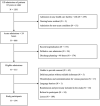Brain injury biomarkers do not predict delirium in acutely ill older patients: a prospective cohort study
- PMID: 36973363
- PMCID: PMC10041516
- DOI: 10.1038/s41598-023-32070-0
Brain injury biomarkers do not predict delirium in acutely ill older patients: a prospective cohort study
Abstract
Delirium is a common, serious, and often preventable neuropsychiatric emergency mostly characterized by a disturbance in attention and awareness. Systemic insult and inflammation causing blood-brain-barrier (BBB) damage and glial and neuronal activation leading to more inflammation and cell death is the most accepted theory behind delirium's pathophysiology. This study aims to evaluate the relationship between brain injury biomarkers on admission and delirium in acutely ill older patients. We performed a prospective cohort study which analyzed plasma S100B levels at admission in elderly patients. Our primary outcome was delirium diagnosis. Secondary outcomes were association between S100B, NSE and Tau protein and delirium diagnosis and patients' outcomes (admissions to intensive care, length of hospital stay, and in-hospital mortality). We analyzed 194 patients, and 46 (24%) developed delirium, 25 on admission and 21 during hospital stay. Median of S100B at admission in patients who developed delirium was 0.16 and median was 0.16 in patients who didn't develop delirium (p: 0.69). Levels S100B on admission did not predict delirium in acutely ill elderly patients.Trial registration: The study was approved by the local institutional review board (CAPPESq, no. 77169716.2.0000.0068, October 11, 2017) and registered in Brazilian Clinical Trials Registry (ReBEC, no. RBR-233bct).
© 2023. The Author(s).
Conflict of interest statement
The authors declare no competing interests.
Figures
References
Publication types
MeSH terms
Substances
Associated data
LinkOut - more resources
Full Text Sources
Medical
Miscellaneous



